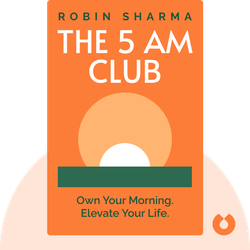Try Blinkist to get the key ideas from 7,000+ bestselling nonfiction titles and podcasts. Listen or read in just 15 minutes.
Start your free trial
Blink 3 of 8 - The 5 AM Club
by Robin Sharma

How Fungi Make Our Worlds, Change our Minds and Shape Our Futures
Entangled Life by Merlin Sheldrake explores the fascinating world of fungi and their interconnections with all living things. This book challenges the way we think about our relationship with the natural world and uncovers the mysteries of the underground fungal network.
The slime mold Physarum polycephalum is a deft problem-solver. When faced with a labyrinth, it’s able to compare different courses of action and determine the most efficient way out.
In one experiment, Japanese researchers placed Physarum in petri dishes modeled on the Greater Tokyo area. Oat flakes, which the fungus could use as food, were used to mark out major urban hubs, while harmful bright lights signified obstacles like mountains. After just one day, the slime mold figured out the quickest route among the oat flakes. Remarkably, its network resembled Tokyo’s existing rail system almost identically.
Physarum is able to navigate its surroundings and make decisions despite having no brain or central nervous system. Does that mean it lacks intelligence? Or could it be that Physarum and other fungi do possess intelligence – just a completely different kind of intelligence from humans?
The key message here is: Fungi challenge our conceptions of intelligence and individuality.
Fungi are a form of network-based life, made up of a collection of thin tubes called hyphae. When hyphae grow, branch, and tangle, they form the dense network known as mycelium. But hyphae also form into fruiting bodies like mushrooms. Slice open a mushroom and you’re looking at the very same material that makes up the rest of the mycelium. Often, the purpose of these fruiting bodies is to disperse reproductive spores.
Sounds pretty simple. But try to answer this question: Are mycelial networks individuals or collectives?
On one hand, we can view each mycelial network as a swarm of hyphal tips. Each tip operates individually; there is no leader or central command center. Yet, at the same time, all hyphal tips are connected to one another – you can’t dismantle a mycelial network hypha by hypha. Reduce a mycelium to just one thin tube and it can regenerate the entire network. This means mycelium is at once a single entity and a multitude of individuals.
Why might this matter to us humans? After all, it’s easy for us to define our individual selves. We end where our bodies end, right?
Well, not quite. Our bodies contain entire communities of bacteria, microbes, genes, and cells obtained or inherited from disparate sources. Without them, we’d become sick or even die. Perhaps we, like fungi, are living communities, at once individual and collective. And perhaps it’s time we reevaluated our time-honored notions of individuality, autonomy, and self.



Entangled Life (2020) ushers us into the vast, hidden world of fungi. In it, we follow molds, yeasts, lichens, and many other fungi as they creep through the soil, intoxicate us with their scent, and induce mesmerizing visions. With a change in perspective, we can begin to see the world from a more fungal point of view – and understand how these organisms might be the key to our future survival.
Entangled Life (2020) takes readers on an extraordinary journey into the fascinating world of fungi and their hidden connections with all life forms. Here's why this book is definitely worth reading:
A ripe truffle broadcasts an unambiguous summons in chemical lingua franca, a pop scent with mass appeal . . . .

It's highly addictive to get core insights on personally relevant topics without repetition or triviality. Added to that the apps ability to suggest kindred interests opens up a foundation of knowledge.
Great app. Good selection of book summaries you can read or listen to while commuting. Instead of scrolling through your social media news feed, this is a much better way to spend your spare time in my opinion.
Life changing. The concept of being able to grasp a book's main point in such a short time truly opens multiple opportunities to grow every area of your life at a faster rate.
Great app. Addicting. Perfect for wait times, morning coffee, evening before bed. Extremely well written, thorough, easy to use.
Try Blinkist to get the key ideas from 7,000+ bestselling nonfiction titles and podcasts. Listen or read in just 15 minutes.
Start your free trial
Blink 3 of 8 - The 5 AM Club
by Robin Sharma
What is the main message of Entangled Life?
The main message of Entangled Life is that fungi play a crucial role in shaping our world and hold the potential for solving complex problems.
How long does it take to read Entangled Life?
The estimated reading time for Entangled Life is a few hours. The Blinkist summary can be read in just 15 minutes.
Is Entangled Life a good book? Is it worth reading?
Entangled Life is a fascinating and insightful book that explores the hidden world of fungi. It's definitely worth reading for anyone interested in the wonders of nature.
Who is the author of Entangled Life?
The author of Entangled Life is Merlin Sheldrake.